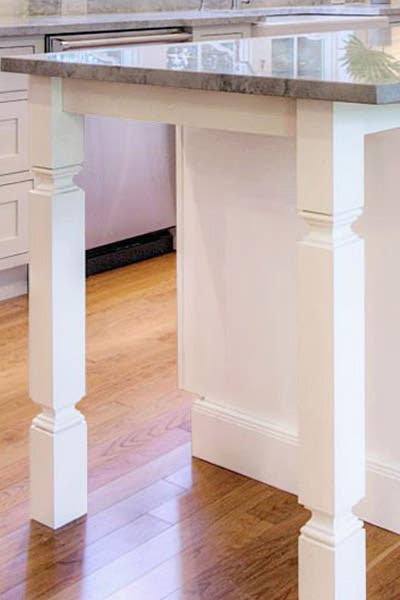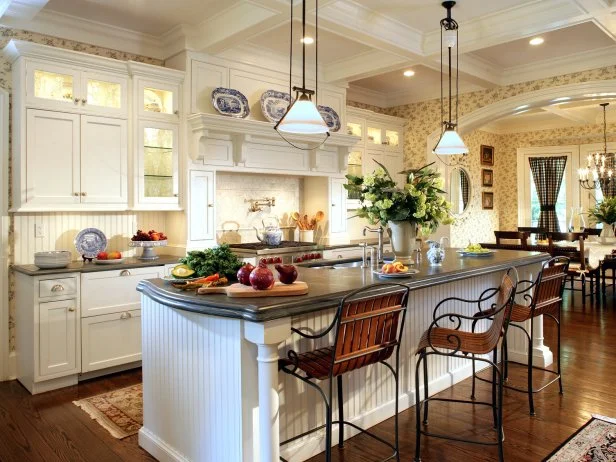Include Stability and Charm with Tough Legs For Kitchen Island Installations
Include Stability and Charm with Tough Legs For Kitchen Island Installations
Blog Article
Trick Considerations for Discovering the most effective Legs For Cooking Area Island for Your Layout
When picking the perfect legs for your kitchen island, a number of vital considerations enter into play that can significantly influence both performance and aesthetics. The selection of height, design, and product must line up with your overall cooking area layout to guarantee a harmonious appearance. Additionally, security and maintenance needs are critical for long-term use and convenience of treatment. Comprehending these aspects can boost your kitchen's functionality and visual appeal, yet the nuances of each consideration can usually be neglected. What implications might these selections carry your kitchen's general ambience?
Determine Your Design Choice
Identifying your style choice is critical when selecting the suitable legs for your kitchen island. The legs of your kitchen island not only serve a functional objective however additionally contribute dramatically to the total visual of the space. Recognizing your design style-- be it modern, rustic, standard, or commercial-- is vital.
For a modern-day kitchen area, consider streamlined, minimalistic legs that enhance open rooms and tidy lines. On the other hand, a rustic setup might profit from even more durable, farmhouse-style legs constructed from reclaimed materials. Typical kitchens commonly favor turned or ornate legs, which can add a touch of elegance and class. An industrial visual might call for steel legs that highlight a raw, incomplete look.
Furthermore, take into consideration the elevation and proportion of the legs in relationship to the island's surface. Inevitably, your style choice will affect not only the option of legs but likewise the general consistency of your cooking area's design.
Choose the Right Product
Picking the right material for your kitchen area island legs is essential in making certain both sturdiness and visual allure. Numerous products supply distinct advantages, and the option frequently shows your style choices and practical demands.
Timber is a popular choice, offering warmth and flexibility. It can be discolored or painted to match your kitchen design, making it adaptable to different styles, from rustic to contemporary. Wood may call for normal upkeep to protect its appearance and integrity.

If you seek an one-of-a-kind touch, think about acrylic or glass products. They can create an illusion of room and lightness in your kitchen, making them an exceptional selection for smaller locations - Legs For Kitchen Island. However, these choices may call for careful handling and maintenance to avoid scratches.
Eventually, the product you choose ought to line up with your cooking area's overall style, making sure that the legs offer both functional and ornamental objectives.
Consider Height and Proportions
When making a cooking area island, height and proportions play an important duty in making certain functionality and comfort. The typical elevation for a cooking area island typically ranges from 36 to 42 inches, aligning with conventional counter heights or bar elevations, respectively. This dimension is vital for harmonizing with surrounding kitchen counters and feceses, allowing simplicity of use during meal prep work and social communications.
Furthermore, the island's percentages must enhance the total cooking area design. A well-proportioned island ought to not overwhelm the room; instead, it must produce a balanced visual. Take into consideration the proportion between the island's size and size, ensuring it provides ample area without crowding the kitchen area. A general standard is to preserve a width of 24 to 48 inches, facilitating activity and availability.
Moreover, the elevation of the legs or base can influence the aesthetic appeal and capability. Taller legs may offer a more modern-day, ventilated feeling, while much shorter ones can stimulate a traditional, based appearance. Eventually, carefully thinking about elevation and percentages will result in a cooking area island that is both functionally effective and visually attractive, boosting the overall layout of the space.
Assess Stability and Durability
A kitchen area island's legs must not only enhance its height and proportions yet also offer ample stability and toughness to sustain everyday tasks. The legs are important to the general capability of the island, as they birth the weight of the countertop and any type of added loads, such as appliances or food prep work jobs.
When analyzing stability, it is important to take into consideration the leg layout and material. Strong steel or strong wood legs often offer exceptional stamina contrasted to lighter materials like engineered wood or plastic. Furthermore, a broader base can boost security, minimizing the danger of tipping or tottering throughout usage.
Toughness is just as vital; the legs need to stand up to damage from day-to-day usage. Think about surfaces that secure against scratches, dents, and moisture, specifically in a cooking area setting. Assess the quality of construction, such as joints and attachments, which can substantially influence the legs' long-term performance.
Ultimately, spending in well-crafted legs that prioritize security and sturdiness will ensure your cooking area island Visit Your URL stays a trustworthy workspace for many years ahead, boosting your culinary experiences while maintaining visual charm.
Consider Upkeep and Care
Upkeep and care are critical factors to consider for guaranteeing the longevity and efficiency of kitchen island legs. When picking legs, it is necessary to evaluate the products used, as various choices call for varying degrees of upkeep. For circumstances, wooden legs may call for regular refinishing or securing to stop dampness damage and scrapes, while steel legs may require regular polishing to keep their shine and stop corrosion.
Furthermore, the surface put on read here the legs can influence maintenance requirements. A high-gloss coating may be much easier to tidy but might reveal scratches and fingerprints a lot more conveniently than a matte finish. It is recommended to select products and coatings that complement your lifestyle; for example, if you regularly organize celebrations, select resilient materials that can stand up to damage.
In addition, consider the cleaning process involved in maintaining these legs. Smooth surfaces typically need very little effort, while complex designs might collect dirt and grime, demanding even more labor-intensive cleansing methods. Legs For Kitchen Island. Eventually, considering the maintenance and care required for your chosen kitchen area island legs will not only enhance their aesthetic allure yet additionally guarantee their useful honesty gradually
Final Thought
Finally, choosing the ideal legs for a kitchen island necessitates careful factor to consider of numerous variables, consisting of design style, material selection, maintenance, height, and security. Each aspect plays a vital function in ensuring that the legs not just improve the visual allure of the cooking area however also give the needed support and durability for day-to-day use. A well-informed choice will eventually add to a practical and visually pleasing cooking area atmosphere.
The legs of your cooking area island not only serve a practical purpose yet also add substantially to the overall visual of the space.Upkeep and treatment are important considerations for making certain the longevity and efficiency of kitchen island legs. Wood legs might need routine refinishing or sealing to protect against moisture damages and scratches, while metal legs might need a fantastic read routine brightening to maintain their sparkle and prevent rust.
Inevitably, factoring in the maintenance and treatment required for your selected kitchen area island legs will not only improve their visual appeal but also ensure their useful stability over time.

Report this page